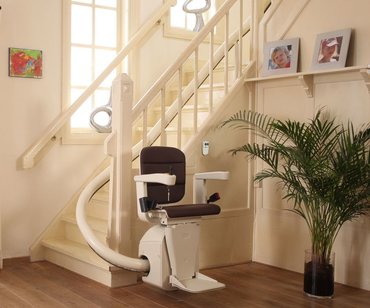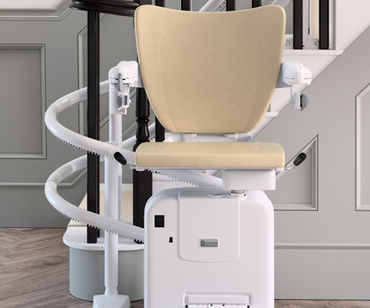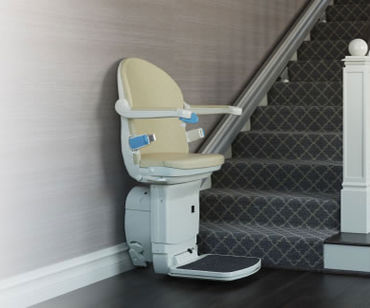The best arthritis exercises to ease pain and stiffness

Living with arthritis can be a source of frustration as people adapt to limited mobility. It also means receiving various treatments, changing eating habits and, as arthritis progresses, installing mobility aids such as a stairlift. However, there are home exercises that can help your arthritis. We have collected some of the simplest ones to try in this guide, including everything from exercises for knee arthritis to finger, hip, and ankle arthritis exercises.
Is exercise good for arthritis?
It is important to keep active despite arthritis, as a lack of motion can lead to worsening effects. Arthritis Action calls this the ‘deconditioning cycle’: “avoiding activity due to pain is not advised as this will lead to the joints getting a little stiffer and the muscles weakening.”
Arthritis affects joints, and there are multiple causes for it. Inflammatory arthritis is an autoimmune condition where the immune system works against the body, and this causes inflammation of the joints. A common example of this is Rheumatoid Arthritis. Degenerative or mechanical arthritis affects the cartilage in joints to protect the bones from damaging each other with repetitive use. Over time, the cartilage becomes thinner and rougher, which the body attempts to heal, but this can result in overgrowing, which alters the shape of the joint. This is known as osteoarthritis.
Arthritis is often found in joints that sustain high impact, such as knees or hips, but also in those that are found to make repetitive motions, like fingers. The different sources for arthritis mean different types of exercise must combat the effects. These are strengthening or stretching exercises designed to either increase the strength of the joints or improve the range of mobility.
The best exercises for arthritis
All of the below exercises are low impact to reduce the stress caused on the joints in question, but they are also easily incorporated into daily routines. These arthritis exercises use only the weight of your body or household objects.
Hand exercises for arthritis

Hands need strengthening and stretching exercises as we rely on them for the simplest tasks. Being unable to do up buttons on a shirt or open doors due to a lack of mobility or strength can be frustrating and reduces your independence. Many people find that doing hand exercises under warm water is helpful. These exercises were advised by Monique Turenne, OTR/L, a certified hand therapist at Johns Hopkins Hospital's Department of Physical Medicine and Rehabilitation.
Making a fist
Stiffness, lack of mobility and thumb pain are often issues in arthritic hands, along with swollen joints. By making a gentle fist (not squeezing or stretching too hard), you use all of your fingers, and if the thumb is tucked in, it ensures that it experiences its full range of motion. Do not strain your hands if you cannot make a tight fist. Just continue with this exercise 3-10 times a day.
Finger bends
This is one of the best finger exercises for arthritis. Isolating the fingers allows you to better understand where the problematic joints are and work on them individually. Many struggle to move the fourth finger separately from the third or littlest fingers; however, as you concentrate on one finger at a time, you can ignore the movement of the other digits.
Finger lifts
Holding each finger in a lifted position for several seconds strengthens the individual joints. If some fingers are weaker than others, this exercise allows you to work on them by increasing the time you keep them lifted or the number of repetitions of this exercise performed in a day. Ensure you do this exercise against a flat surface to fully measure the motion.
Wrist stretch
Your wrists are often affected by arthritis and can be overlooked by many hand exercises for arthritis. Strength is usually more of a problem than mobility due to how we use our wrists; thus, this is a strengthening exercise. Make sure not to push too hard, as this can damage the joint. You can also push the heel forward to oppose the original stretch and follow the full range of movement.
Knitting
Many everyday activities involve repetitive hand movements, but those that require both nimbleness and grasping can improve strength and mobility. These can be knitting with light needles and crocheting, which involve the dexterity of both fingers and wrists.
READ ALSO: Knitting tips for beginners
Knee exercises for arthritis

As key weight-bearing joints, your knees are important to keep strong and mobile. If your knees are affected by arthritis, your ability to move about, sit, stand and walk for any distance is seriously compromised.
According to Healthline: “Exercising an arthritic knee may seem counterintuitive, but regular exercise can actually lessen — and even relieve — arthritis pain and other symptoms, such as stiffness and swelling.”
To retain movement, these arthritis knee exercises should start when you feel stiffness and after seeing a medical professional.
Squats
Squats improve balance and core muscles as well as strengthen your knees. Though squats are for all levels of ability, there is no expectation to go any lower than you are comfortable. Instead, lowering yourself into a chair while holding the correct position and returning to standing will improve your knee strength.
Alternatively, if you struggle to maintain the position, Arthritis Health suggests: “Position the body in a full squatting position with the back flat against the wall. Raise the body by straightening the legs and sliding the back up against the wall, then lower the body using the same method”. This exercise should be repeated for a few minutes a day.
Step-ups
Though this is something most of us do every day, the motion is fantastic for gently increasing your heart rate and improving your knees by controlling a motion you use regularly. This strengthens the muscles around the joint and loosens any stiffness you may feel at the start of the day or with initial movements.
Dr Axe is a certified fitness instructor, strength and conditioning specialist and Doctor of Chiropractic who recommends this exercise but mentions the importance of safety: “Find something that you can safely step up onto, such as the first or second step of a flight of stairs or a fitness bench. Make sure that whatever you step on, it is sturdy.”
Straight leg raises
This can be done sitting or standing by simply raising one leg slightly off the ground before you. However, sitting may be better if your balance is not the best. This is another strengthening exercise you can do while watching TV or reading. It improves the mobility of the knee through the pendulum motion but also creates movement in both the ankle and feet as you point your toe to raise your leg.
By walking upstairs or lowering yourself onto the sofa, you are working key muscles that keep your joints strong and adding extra movement, increasing the circulation (due to increased heart rate) in your body.
READ ALSO: Best stretching exercises for over 60s
Feet and ankle arthritis exercises

Inflammation is a regular occurrence in this area due to poor circulation. Unfortunately, this is another example of a deconditioning cycle where the inflammation causes pain, which people avoid by moving less; this causes poorer circulation and, therefore, more inflammation. These easy exercises will increase the blood flow and test the available range of movement.
Plantar fascia stretch
Despite the fancy name, this exercise involves no fancy equipment, just rolling your foot from heel to toe across the surface of something cylindrical (such as a bottle or a ball). This uses many different areas of your feet, ankles, and knees to a certain extent. Roll in all directions for a full range of motion. Arthritis Research UK suggests repeating this motion twice a day.
Heel raises
By gently lifting and lowering your heels, you improve your ankle motion and tense your calves. Through strengthening this key stabilising muscle, you keep your knees and ankles aligned and balanced. This motion should be repeated up to twenty times a day per foot.
Moving your feet is often an unconscious act unless it causes you pain. Trying to do this exercise while watching your favourite programs can greatly improve the well-being of your feet without enormous amounts of effort.
READ ALSO: How to get involved in an accessible sport
Hip arthritis exercises

The hips are another main weight-bearing joint; however, due to being a different type of joint - a saddle joint with 360° of motion - building mobility is as important as strength. With recent years showing a rise in people having hip replacements, gentle exercises for hip arthritis can be helpful.
Hip extension
This strengthening exercise also increases motion by raising your leg out in front of you. By holding the pose for lengthening periods, you increase the strength of the muscles, and thus, this is an exercise you can continue to build on. Keeping the knee straight focuses on the gluteus muscles, which keep the hips aligned and stable and increase circulation down the entire leg.
Hip abduction
This is a similar movement to the hip extension; however, by lifting your leg sideways, you use a different collection of muscles and increase the joint's flexibility in an alternative direction. By pointing the toe, you increase the circulation in the foot.
Quadriceps exercise
Either lying or sitting with straight legs, pointing your toes towards you and pushing your knees firmly to the floor, you should feel a tightness in the front of your leg. Using your feet improves circulation while strengthening the quadriceps, which helps alleviate the weight from your hips. Ensure you do this on a comfortable surface and repeat no more than ten times daily.
Hip flexion
This exercise mirrors and exaggerates a motion we do every day as you raise your knee up so it's nearly horizontal with your waist. By strengthening the muscles that we usually use, we loosen and strengthen the joints ready for our daily activities. This movement will likely raise your heart rate a little and thus improve your circulation. Be aware that the knee should not be raised above a 90° angle.
Dr Mercola from Peak Fitness proposes combining Hip Flexions with Hip Abductions: “Lying on your back, bring one knee up toward your chest. Holding your knee with both hands, roll your knee from one side to the other for 20 seconds”.
Though some hip exercises must be done lying down, many merely require you to hold onto a surface. This makes them perfect for when you are cooking, either marching on the spot or lifting a leg, waiting for something to boil or the toaster to pop.
READ ALSO: Mobility scooters: All your questions answered
Shoulder arthritis exercises

There are some very helpful arthritis exercises for shoulders, helping you to manage pain and reduce stiffness via some gentle movements.
Shoulder pendulum
This is a very gentle should exercise. Stand with one hand resting on a chair and let your other arm hang down, then try to swing it gently backwards and forwards and in a circle. Repeat the motion about five times. This will stretch your outer shoulder and rotator cuff.
Wall push-ups
Wall push-ups are just like regular push-ups, but instead of lying on the floor, you are leaning against the wall. This exercise can strengthen your shoulders, arms, and chest muscles. Stand facing the wall with your feet should width apart and arms stretching out against the wall. Keeping your hands flat against the wall, bend your elbows so that your chest gets closer to the wall, then slowly push yourself back until your arms are straight.
Cross arm stretch
A cross-arm stretch helps to stretch the back of your shoulder, improving mobility and reducing stiffness. When standing straight or sitting upright in a chair, pull one of your arms across your chest as far as is comfortable. Hold the stretch for 30 seconds and repeat with the other arm.
READ ALSO: Vitamins for over 60s: Your questions answered
Arthritis exercises for reducing stiffness and pain
From hips to knees, there are plenty of helpful exercises to help with arthritis. We hope that some of the above gentle arthritis exercises will help you to find some relief from any pain that you are experiencing and improve your mobility.
For more tips, guides, and advice, visit our news page.



